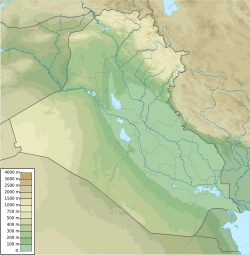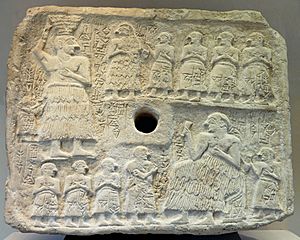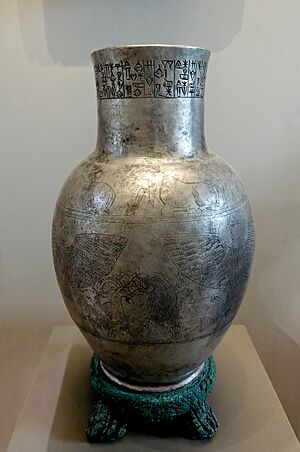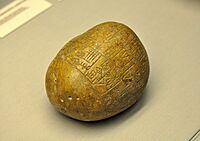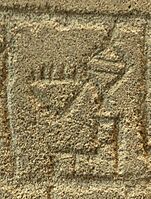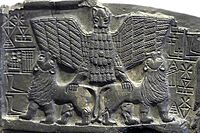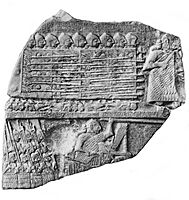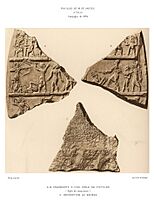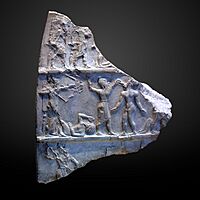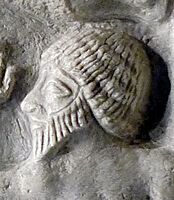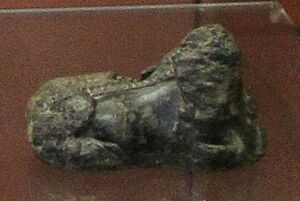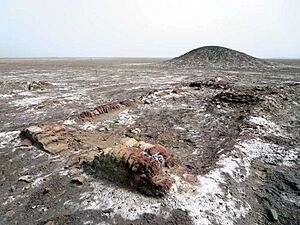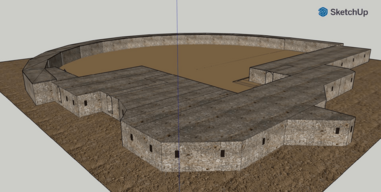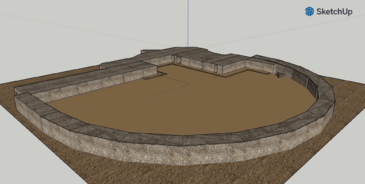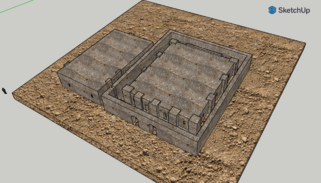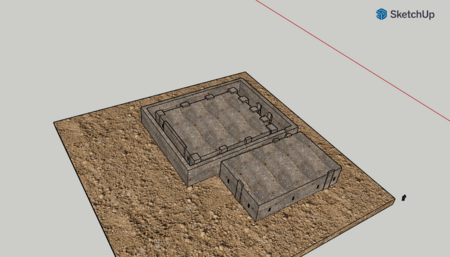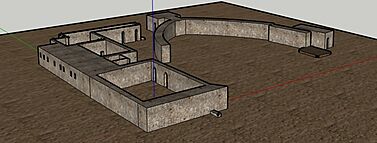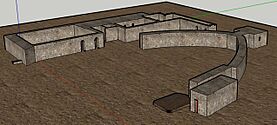Lagash facts for kids
|
𒉢𒁓𒆷𒆠
|
|
| [[File::None at this time|frameless]] | |
| Alternative name | Al-Hiba |
|---|---|
| Location | Al-Shatrah, Dhi Qar Governorate, Iraq |
| Region | Mesopotamia |
| Coordinates | 31°24′41″N 46°24′26″E / 31.41139°N 46.40722°E |
| Type | Settlement |
| Area | 400 to 600 ha |
| History | |
| Founded | 3rd millennium BC |
| Periods | Early Dynastic, Sargonic, Ur III |
| Site notes | |
| Excavation dates | 1887, 1968-1976, 1990, 2019-present |
| Archaeologists | Robert Koldewey, Vaughn E. Crawford, Donald P. Hansen |
Lagash (cuneiform: 𒉢𒁓𒆷𒆠; Sumerian: Lagaš) was a very old city-state in Mesopotamia, which is now modern-day Iraq. It was located between the Euphrates and Tigris rivers, about 22 kilometers east of the town of Al-Shatrah. Lagash, also known as Al-Hiba today, was one of the earliest and most important cities in the Ancient Near East.
Nearby cities like Nina and Girsu were also part of the Lagash state. Girsu, about 25 kilometers northwest of Lagash, was the religious heart of the state. The main temple for the god Ningirsu, called the E-ninnu, was located there.
Contents
History of Lagash
Even though some very old pottery pieces from the Uruk period were found, Lagash really started to grow around 3000 BC. This was during the Early Dynastic I period. Surveys and excavations show that Lagash was at its biggest during the Early Dynastic III period (around 2500–2334 BC), covering about 500 hectares. This time is known as the First Dynasty of Lagash.
Later, Lagash was controlled by the Akkadian Empire for a few centuries. After that empire fell, Lagash became powerful and independent again during the Second Dynasty of Lagash. But then, it came under the control of the 3rd Dynasty of Ur. After the Ur dynasty fell, Lagash was mostly empty until a fortress was built there much later, around 200 BC.

The First Dynasty of Lagash (around 2520 – 2342 BC)
The rulers of Lagash are not listed in the famous Sumerian King List, even though Lagash was a very important city. One old tablet, called The Rulers of Lagash, lists 30 rulers with very long reigns. It seems to be a funny story, but it does mention some real rulers from the First Dynasty of Lagash, like Ur-Nanshe and Gudea.
We don't know much about the first two rulers, En-hegal and Lugalshaengur. A king from another city, Mesilim of Kish, even called Lugalshaengur a "prince" of Lagash.
Ur-Nanshe: A Builder King
We know more about Ur-Nanshe because many of his inscriptions have been found. Most of them talk about building temples. One inscription says he built a channel to protect against the Amorites. He also claimed that ships from Dilmun (a trading partner) brought wood to Lagash as tribute. His son, Akurgal, ruled for a short time after him.
Eannatum: A Powerful Conqueror
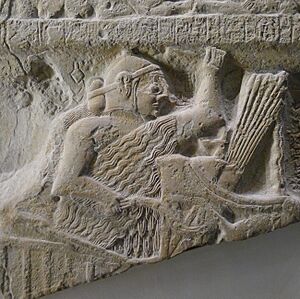
Eannatum, Ur-Nanshe's grandson, made Lagash a huge power. He conquered many areas in Mesopotamia and to the east. An inscription found in the city of Adab says that Eannatum defeated many cities, including Elam, Umma, and Ur. He also built a well for the god Ningirsu.
Eannatum also claimed to have captured the city of Akshak and killed its king. He even took the city of Uru'az on the Persian Gulf and collected tribute from as far away as Mari. However, many of the places he conquered often rebelled. During his rule, temples and palaces were fixed or built, and canals and water reservoirs were dug.
Lagash and the nearby city of Umma had a long-running border dispute over a fertile area called Guʾedena. This dispute went back many years. Eannatum restored the border and its markers.
The famous Stele of the Vultures tells the story of a battle between Lagash and Umma around 2450 BC. The stele shows that King Eannatum, inspired by his city's god, led his army to defeat Umma. The engravings show Eannatum leading his men on foot, and the Lagash army advancing in a tight formation called a phalanx. This battle is one of the earliest organized battles ever shown in art!
Eannatum was followed by his brother, En-anna-tum I. His rule also involved continued fighting with Umma, as described in a long tablet. The ruler of Umma, Ur-Lumma, even diverted water and destroyed monuments belonging to Lagash.
Entemena and Later Rulers
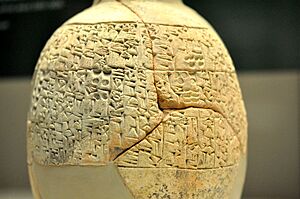
The next ruler, Entemena, made Lagash even stronger. Many inscriptions from his time have been found. He was a contemporary of Lugalkinishedudu of Uruk.
After Entemena, there were a few more rulers, including Enannatum II, Enentarzi, and Lugalanda. The last ruler of this dynasty was Urukagina. He is famous for his important changes to laws, society, and the economy. His laws might even be the first known legal code in history! However, he was defeated by Lugalzagesi, who was first the ruler of Umma and then Uruk. This defeat ended the First Dynasty of Lagash.
About 1800 clay tablets from the reigns of the last three rulers have been found. Most of these tablets are about daily administration and come from the "woman’s quarter," which was controlled by the Queen.
-
The name "Lagash" (𒉢𒁓𒆷) written vertically in cuneiform from the time of Ur-Nanshe.
-
The armies of Lagash, led by Eannatum, fighting against Umma.
Lagash Under the Akkadian Empire
Around 2300 BC, Sargon of Akkad conquered many cities in Sumer. After taking Uruk and Ur, he "laid waste" to the area from Lagash to the sea. He then went on to conquer and destroy Umma and collected tribute from Mari and Elam. Sargon defeated 34 cities in total.
Sargon's son, Rimush, faced many rebellions. He had to reconquer cities like Ur, Umma, Adab, Lagash, Der, and Kazallu from rebellious local rulers. Rimush kept detailed records of his campaigns. While the original text mentions mass slaughter, it's important to know that these were very difficult times for the Sumerian city-states, with many people being captured or forced to leave their homes.
A large stone carving, or stele, found in Girsu (part of Lagash) is believed to show Rimush's victory over Lagash. It mentions Akkad and Lagash.
The Second Dynasty of Lagash (around 2230 – 2110 BC)
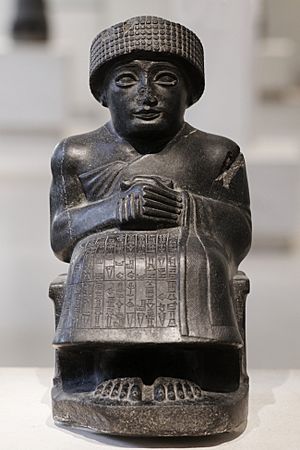
At first, Lagash was still under the control of the Akkadian Empire during the reigns of Lugal-ushumgal and Puzur-Mama. However, after the Akkadian Empire weakened, Lagash became fully independent under Ur-Ningirsu I. Unlike the first dynasty, rulers of this period used "year names" to mark important events.
Not much is known about some of the rulers who followed, like Pirig-me, Lu-Baba, Lugula, and Kaku. The next important ruler was Ur-Baba. Three of his daughters married later rulers of Lagash, including the famous Gudea. Ur-Baba's inscriptions mostly talk about religious buildings, like restoring the "Eninnu, the White Thunderbird" temple.
Gudea: The Great Builder
Even though the Gutians had taken over some power after the Akkadian Empire fell, Lagash became very rich and powerful under Gudea. Thousands of inscriptions and many statues of Gudea have been found from his time. Many clay tablets about daily life and administration were found at nearby Girsu. The famous Gudea cylinders, which contain the longest known text in the Sumerian language, were also found there.
Gudea was known for building and restoring many temples. He also led some military actions to the east against Anshan and Elam. Most of his year names are about religious events, except for one that mentions building a canal and another that says "Year in which the city of Anszan was smitten by weapons."
Gudea was followed by his son Ur-Ningirsu, and then Ur-gar. Not much is known about their reigns.
Nam-mahani: The Last Ruler
The next ruler, Nam-mahani, is mainly known for being defeated by Ur-Nammu, the first ruler of the Ur III empire. Nam-mahani is considered the last ruler of the Second Dynasty of Lagash. The Code of Ur-Nammu states that Ur-Nammu "slew Nam-ha-ni the ensi of Lagash." Many of Nam-mahani's inscriptions were damaged, and statues of him and his wife were even beheaded by Ur-Nammu, which was a way to erase their memory.
Lagash Under the Ur III Empire
When Lagash was controlled by the Ur III Empire, it became the largest and most successful province. It was so important that the second-highest official in the empire, the Grand Vizier, lived there. We know the name of one governor of Lagash during this time, Ir-Nanna. However, after the fifth year of the last Ur III ruler, Ibbi-Sin, Lagash was no longer controlled by Ur.
Archaeology: Discovering Lagash
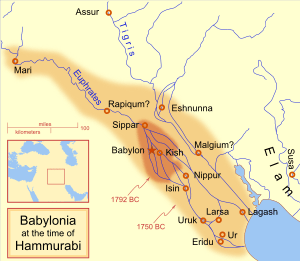
Lagash is one of the largest ancient sites in its region. It measures about 3.5 kilometers from north to south and 1.5 kilometers from east to west. It's not very tall, only about 6 meters above the flat land. Much of the oldest parts of the city are now under the water level, making them hard to study. Drone surveys have shown that Lagash was built on four marshy islands, some of which had gates.
The site was first dug up by Robert Koldewey in 1887. Later, in 1953, a survey found the first clear evidence that this site was indeed Lagash.
More major excavations happened between 1968 and 1976 by a team from the Metropolitan Museum of Art and New York University. They found twelve layers of archaeological remains, with the bottom nine layers belonging to the Early Dynastic period. They focused on digging up the Ibgal temple of the goddess Inanna and the Bagara temple of Ningirsu, along with an administrative area. The team came back in 1990 for another season. Temples for other goddesses like Gatumdag, Nanshe, and Bau are known to have existed but haven't been found yet.
A canal connected the E-ninnu temple in Girsu, the E-sirara temple in Nigin, and the Bagara temple in Lagash. This shows that these three cities were part of one big state. In 1984, a survey found that most discoveries were from the Early Dynastic III period.
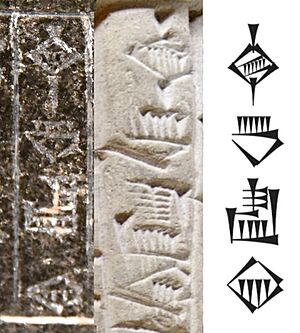
In 2019, new archaeological work started again at Lagash, led by Dr. Holly Pittman from the Penn Museum. They continued their work in 2021 and 2022. This work focused on an industrial area, along with streets, homes, and kilns (ovens for pottery). They also used drones and satellites to map Lagash from above. In late 2022, they found something really cool: a public eatery! It had ovens, a cooling system, benches, and lots of bowls and cups.
Area A (The Ibgal of Inanna)
This temple complex was also known as Eanna during later periods. The Ibgal was a special part of Eanna, dedicated to the goddess Inanna.
Building Levels in Area A
The oldest level of Area A was used from the Early Dynastic (ED I) period all the way to the Ur III period. People used it for daily worship and big celebrations, especially for the queen of Lagash during special festivals.
Level I has an oval wall that surrounds a large courtyard. This wall was probably about 130 meters long. The temple building itself was connected to the courtyard by steps. Inside the building, archaeologists found 25 rooms. Both the temple and the oval wall were built with special mud bricks called plano-convex bricks, which were common back then.
Two more levels, Level II and Level III, are found underneath Level I. Interestingly, all three levels have similar layouts and were built with similar materials. When people built new structures on top of old ones, they would sometimes destroy parts of the older buildings while keeping others.
Area B (3HB and 4HB Buildings at Bagara of Ningirsu)
The 3HB Building
Three building levels were found here, with 3HB III being the oldest and best preserved. All three levels have a central building with niches and buttresses (support structures), surrounded by a low wall.
| Building Level | Building Material | Time Period | Notes |
| 3HB III | Plano-convex bricks, mud plaster | ED IIIB (during Eannatum’s rule or later) | Dimensions: 3HB Building: 24 x 20m; Enclosure Wall: about 31m x 25m |
| 3HB II | Plano-convex bricks, mud plaster | ED IIIB – Late Akkadian | |
| 3HB I | Plano-convex bricks, mud plaster | Late – Post-Akkadian |
Some archaeologists think the 3HB Building was a "kitchen temple" for the god. Others suggest it was a shrine within the Bagara complex, as its design is more like other temples than kitchens.
The 4HB Building
Archaeologists found five building levels here. The layout of 4HB V is not fully known. Levels 4HB IV-4HB I all shared the same layout.
| Building Level | Building Material | Time Period | Notes |
| 4HB V | Plano-convex bricks | ED III (from pottery evidence) | |
| 4HB IVA | Plano-convex bricks | ED III (from pottery evidence) | |
| 4HB IVB | Plano-convex bricks | ED IIIB | Dimensions: 4HB Building: 23 x 14m |
| 4HB III | Plano-convex bricks | ED IIIB – Late Akkadian | |
| 4HB II | Plano-convex bricks | Late – Post-Akkadian | |
| 4HB I | Plano-convex bricks and flat, square bricks | Gudea’s rule |
Some suggest the 4HB Building was a brewery because ovens, storage vats, and a tablet mentioning "the brewery" were found. Another idea is that it was a kitchen, as it looks similar to temple kitchens found in Ur and Nippur.
Area C
This area is southeast of Area B. It has a large administrative area from the Early Dynastic period with two building levels. In one level, seals and tablets from rulers like Eannatum, Enannatum I, and Entemena were found.
Area G
Area G is located between Area B (north) and Area A (south). It has a building complex and a curving wall.
Western Building Complex
Five building levels were found here. Levels IIB, III, and IV show changes and reconstructions. In Level III, benches were built near the courtyards. Seals found here suggest these buildings were used for administration. Fireplaces, storage bins, and pottery were also found.
Curving Wall (Eastern Zone)
A 2-meter wide wall runs from south to north in the eastern part of Area G. This wall and nearby rooms are different from other oval temples built during the Early Dynastic period. Archaeologists found older Early Dynastic I deposits deeper down.
List of Rulers
| Portrait or inscription | Ruler | Approx. dates of reigns (Middle Chronology) | Notes and references |
|---|---|---|---|
| First Dynasty of Lagash (c. 2600 – c. 2260 BC) | |||
| (En-hegal) | r. c. 2600 – c. 2530 BC | Known from one inscription about buying land. | |
| (Lugalshaengur) | r. c. 2530 – c. 2520 | A high priest or prince, mentioned by King Mesilim. | |
| Ur-Nanshe | r. c. 2520 – c. 2465 | King, known for building temples. | |
| Akurgal | r. c. 2464 – c. 2455 | King, son of Ur-Nanshe. | |
| Eannatum | r. c. 2455 – c. 2425 | Grandson of Ur-Nanshe, a powerful king who conquered many areas. | |
| Enannatum I | r. c. 2425 – c. 2405 | Brother of Eannatum, continued conflicts with Umma. | |
| Entemena | r. c. 2405 – c. 2375 | Son of Enannatum I, increased Lagash's power. | |
| Enannatum II | r. c. 2375 – c. 2365 | Son of Entemena, last of Ur-Nanshe's family line. | |
| Enentarzi | r. c. 2365 – c. 2359 | A priest of Lagash. | |
| Lugalanda | r. c. 2359 – c. 2352 | ||
| Urukagina | r. c. 2352 – c. 2342 | King, known for his social reforms, defeated by Lugalzagesi. | |
| Portrait or inscription | Ruler | Approx. dates of reigns (Middle Chronology) | Notes and references |
| Second Dynasty of Lagash (c. 2230 – c. 2110 BC) | |||
| (Lugal-ushumgal) | r. c. 2230 – c. 2210 | Ruled under the Akkadian Empire. | |
| (Puzer-Mama) | r. | Gained independence from the Akkadian Empire. | |
| Ur-Ningirsu I | r. | ||
| Pirig-me | r. | Son of Ur-Ningirsu I. | |
| Lu-Baba | |||
| Lugula | |||
| Kaku | |||
| Ur-Baba | r. c. 2164 – c. 2144 | ||
| Gudea | r. c. 2144 – c. 2124 | Son-in-law of Ur-Baba, a very famous ruler known for his many statues and buildings. | |
| Ur-Ningirsu | r. c. 2124 – c. 2119 | Son of Gudea. | |
| Ur-gar | r. c. 2117 – c. 2113 | ||
| Nam-mahani | r. c. 2113 – c. 2110 | Grandson of Kaku, defeated by Ur-Nammu. | |
See also
- List of cities of the ancient Near East
- List of Mesopotamian dynasties
- The Sumerian Game


